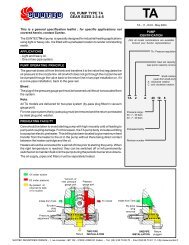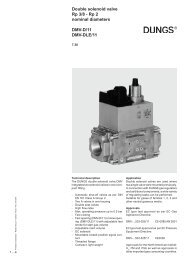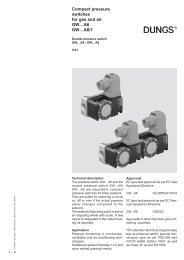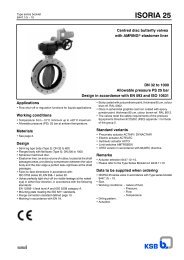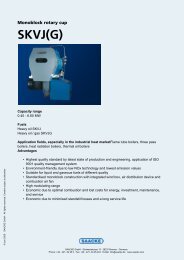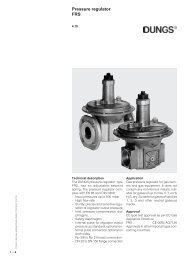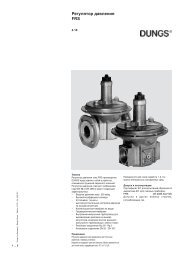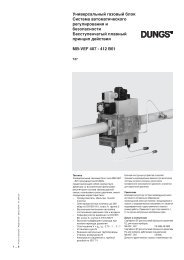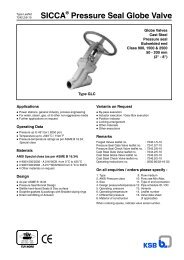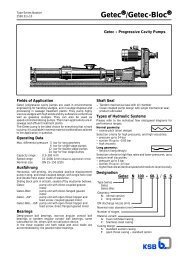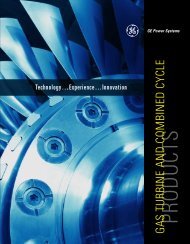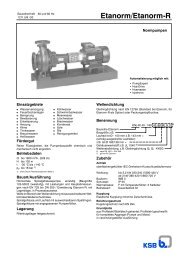C OGENERATION WITH GAS ENGINES - Filter
C OGENERATION WITH GAS ENGINES - Filter
C OGENERATION WITH GAS ENGINES - Filter
Create successful ePaper yourself
Turn your PDF publications into a flip-book with our unique Google optimized e-Paper software.
C <strong>OGENERATION</strong> <strong>WITH</strong> <strong>GAS</strong> <strong>ENGINES</strong>
T ABLE OF C ONTENTS<br />
Comparison of technologies 4/5<br />
Cogeneration plants in general 6/7<br />
Dimensioning 8/9<br />
Economic efficiency 10/11<br />
Possibilities of combination 12/13<br />
Selection of primary energy 14/15<br />
Features of Jenbacher AG 16/19<br />
Scope of supply 20/21<br />
Engine series 22/23<br />
Reference plants 24/25<br />
Jenbacher - Worldwide 26/27<br />
3
4<br />
C OMPARISON OF TECHNOLOGIES<br />
Increased ecological consciousness and the knowledge of the limited<br />
reserves of primary energy in the form of fossil fuels make it necessary to<br />
transform available energy sources economically. Cogeneration plants produce<br />
electricity and heat at decentralized locations, i.e. where they are required.<br />
They offer optimal efficiency in the transformation of energy with minimum<br />
environmental pollution.<br />
Losses usually result from waste heat. For that reason, sensible,<br />
thermodynamic energy converters are those which supply power (usually used to<br />
produce electricity) and heat. This power, however, can also be utilized for the direct<br />
drive of machines such as pumps, compressors (e.g. for refrigerating plants), etc.<br />
2.50<br />
(1 - 4.33 ) . 100 = 42 % savings of primary energy with cogeneration<br />
The energy requirement of cogeneration plants is more than one third less<br />
compared with separate generation of electricity and heat.
Cogeneration plants are not limited to integration into centralized heating<br />
networks, rather they can be more effectively applied for local heat supply with the<br />
generated electricity being used to cover local consumption and/or export to the<br />
utility. The plants also offer themselves for the replacement or addition to existing<br />
heating plants. The total degree of efficiency of cogeneration plants is about 90%.<br />
Since cogeneration plants are usually in the vicinity of consumers, the distribution<br />
losses are less than in the case of central electricity and heat generation.<br />
Combined heat and power is possible with both gas engines and gas<br />
turbines. In comparison to gas turbines, combined heat and power plants with gas<br />
engines indicate clearly higher electrical efficiency (see Illustration) and<br />
considerably lower investment costs. Turbines can be more economically used in<br />
applications with a large constant high value heat requirement of over 110°C or in<br />
large multi-Megawatt installations. For both technologies the designation<br />
„cogeneration plant“ has become established. The space requirement is considerably<br />
smaller than conventional power stations.<br />
(Data referring to Jenbacher power range)<br />
5
Construction - manner<br />
of operation - integration<br />
Scheme of a cogeneration plant<br />
6<br />
C <strong>OGENERATION</strong> PLANTS IN GENERAL<br />
A cogeneration plant consists of an engine (or turbine)/generator set with<br />
heat exchangers for the utilization of the thermal energy in the intercooler,<br />
jacket water, lubricating oil and exhaust gas. A boiler plant specifically for peak<br />
heating demand periods can augment the cogeneration modules.<br />
Electrical connection and control installations serve for distribution of<br />
electricity and engine management. Hydraulic distribution ensures efficient heat<br />
recovery.<br />
The total efficiency of gas engine cogeneration plants attains up to over<br />
90% (30% - 40% electrical and over 50% thermal).
- Mixture intercooler<br />
- Oil heat exchanger<br />
- Engine jacket water heat exchanger<br />
- Exhaust gas heat exchanger<br />
The losses brought about by energy transformation - about 10% - are comprised<br />
of generator, radiation and heat exchanger losses and the remaining heat of the<br />
exhaust gas.<br />
Besides a spark-ignition gas engine, a gas-diesel (dual-fuel) or a diesel<br />
engine can be used as drives, their main disadvantage being, however, the<br />
considerably higher emissions. In many plants with spark-ignition gas engines socalled<br />
mixture-turbocharging is used; here a mixture of air and gas are put under<br />
a higher pressure in a turbocharger. In consequence, one increases the specific<br />
energy density in the cylinders and hence the power in contrast to aspirating-type<br />
engines of comparable size. In combination with the lean-burn engine principle this<br />
results in extremely low NOx emissions without additional secondary treatment of<br />
exhaust gas.<br />
Jenbacher engines developed for use in cogeneration plants attain periods<br />
of operation of 40,000 to 100,000 hours.<br />
7<br />
The energy balance of a<br />
JMS 320 GS Jenbacher<br />
cogeneration module
Yearly heat<br />
requirement<br />
Yearly heat<br />
requirement curve<br />
8<br />
D IMENSIONING<br />
Cogeneration plants are generally dimensioned to meet the heat requirement<br />
of a particular site. For this reason, it is necessary to analyze the annual development<br />
of the heat requirement and to determine a yearly curve broken down into exact<br />
monthly requirements.<br />
Here two rules of thumb are useful:<br />
1. The thermal power of the cogeneration plant should amount to about 30% to<br />
50% of the maximum yearly heat requirement. Experience has shown that<br />
about 50% to 70% of the yearly heat requirement can be covered by the<br />
cogeneration modules. The rest is supplied by boilers for peak load periods.<br />
2. Each cogeneration module should attain at least 4,000 operating hours per<br />
year.
Hot water for domestic requirements and other uses show here a higher<br />
portion of base load. New housing developments are characterized by good thermal<br />
insulation, so that no strongly pronounced peak load periods develop.<br />
A uniform base heat load and high electricity consumption form for<br />
these customers the ideal prerequisites for the use of cogeneration plants. In<br />
addition to this, they can also be utilized for the supply of emergency power.<br />
Since the heat requirement of industrial organizations fluctuates greatly<br />
during production (e.g. breweries), consumption profiles have to be determined to<br />
ensure that a comprehensive and economical energy concept can be achieved.<br />
9<br />
Housing developments<br />
Hospitals<br />
Industrial companies<br />
Typical daily heat and<br />
electricity requirement<br />
in a brewery
Influencing factors<br />
Investment costs of a<br />
cogeneration plant<br />
10<br />
E CONOMIC EFFICIENCY<br />
To document the economic efficiency of a cogeneration plant, one contrasts<br />
savings and returns resulting from the production of electricity and heat with<br />
investment costs.<br />
Investment in a cogeneration plant:<br />
Savings through installation:<br />
• Costs of connection to public<br />
electricity/heating network<br />
Investment costs:<br />
• Cogeneration modules<br />
• Electrical equipment<br />
• Adaptation of the heating system<br />
• Cooling<br />
• Ventilation<br />
• Lubricating oil<br />
• System control<br />
• Building, foundation<br />
• Fuel<br />
• Final acceptance by authorities<br />
• Initial operation<br />
Operation of a plant:<br />
Running savings and returns:<br />
• Electricity tariff and connection costs<br />
• Heat tariff in the case of purchase<br />
from a long-distance network or<br />
costs of own-production of heat<br />
with a boiler<br />
• Costs of power losses avoided by<br />
emergency operation<br />
Running costs:<br />
• Fuel<br />
• Lubricating oil<br />
• Service and maintenance<br />
• Operational personnel<br />
• Insurance<br />
• Engine inspections<br />
The specific investment costs of a cogeneration plant depend on the<br />
power output range and the scope of supply.
The primary criteria for the economical operation of a plant is the assessment<br />
of the generated electricity. This can be utilized for either the plant‘s own<br />
requirements or be fed into the public grid.<br />
The first option above is economically more interesting. In this way the<br />
electricity power prices which are saved can also be credited to one‘s account.<br />
11<br />
Make up of the investment<br />
costs of a cogeneration plant<br />
Typical comparison of<br />
returns and costs regarding<br />
self-production and<br />
purchase in Germany
Cogeneration of heat,<br />
power and cold<br />
12<br />
P OSSIBILITIES OF COMBINATION<br />
Chilled air/fluid can be produced by conventional reciprocating chillers<br />
or absorption chillers. With the latter type the thermal energy of a cogeneration<br />
plant can be utilized.<br />
Advantages through the combination of cogeneration with absorption chillers:<br />
• increase of the module operating time through additional utilization of exhaust heat<br />
with a summer load<br />
• decrease of the connected electrical load and hence reduction of energy costs<br />
Advantages of an absorption chiller in comparison to a conventional reciprocating<br />
chiller:<br />
• environmentally friendly cryogens (no CFC)<br />
• longer service life due to fewer moving parts, hence also<br />
• low maintenance and repair costs<br />
• lower power consumption<br />
Extreme peak demands for chilled air/fluid can be compensated by a compressiontype<br />
refrigerating machine.
The dried sewage sludge is fed into a digestion tank where the anaerobic<br />
fermentation process liberates the methane contained in the biomass. The thermal<br />
energy of the cogeneration plant is used to heat the sewage sludge and therefore<br />
promotes the production of biogas in the digestion tank.<br />
High pressure gas lines must be reduced in pressure for local distribution.<br />
Traditionally, pressure reducing valves performed this task however, expansion turbines<br />
have been used which convert this pressure head into electricity. Turbines however<br />
require the high pressure gas to be heated to prevent icing by the expansion and<br />
a cogeneration plant heat output used for this purpose can result in an extremely<br />
high electrical efficiency.<br />
The employment of hot-cooled engines permits jacket water temperatures<br />
above 110°C. This is interesting, for example, for hospitals and breweries. In the<br />
latter, the temperature levels required in the supply and return lines for bottle<br />
cleaning machines and for the brewing process can be ensured with this method.<br />
The gas engine can be used directly to drive compressors, pumps,<br />
ventilators, etc.<br />
13<br />
The cogeneration plant used<br />
for heating the digestion tank<br />
and drying sewage sludge<br />
The cogeneration plant and<br />
a natural gas driven turbine<br />
used for reduction of the<br />
pressure potential<br />
Hot-cooling<br />
Hydraulic scheme for<br />
the bottle cleaning<br />
machines in a brewery<br />
Direct drive
The calorific value indicates<br />
the energy content<br />
of the primary fuel<br />
14<br />
S ELECTION OF PRIMARY ENERGY<br />
Jenbacher AG has become specialized in utilizing not only gases with an<br />
extremely low calorific value, low methane number and hence low degree of knock,<br />
but also gases with a very high calorific value.<br />
Besides the „standard use“ of natural gas, landfill gas also represents a<br />
significant potential, above all regarding the aspect of environmental protection<br />
and preservation of resources.<br />
Sewage gas is very well suited for the operation of gas engines, since the<br />
knock-resistant methane and the high amount of CO2 contained in it permit a<br />
methane number of over 130. Another opportunity to utilize the energy potential<br />
of waste is through the process of pyrolysis (decomposition of substances by<br />
heat). The resultant pyrolysis gas can be used in a gas engine.
The most important property regarding the use of a gas in a gas engine<br />
is its knock resistance. This is rated according to a methane number. Highly<br />
knock-resistant methane has a methane number of 100. In contrast to this,<br />
butane has a methane number of 10 and hydrogen with a methane number 0 lies<br />
at the bottom of the scale.<br />
Fuel Designation,<br />
Composition (in %)<br />
Methane number<br />
H2 Hydrogen 0<br />
CH4 Methane 100<br />
C2H4 Ethylene 15<br />
C2H6 Ethane 43.7<br />
C3H6 Propylene 18.6<br />
C3H5 Propane 33<br />
C4H10 Butane 10<br />
CO Carbon monoxide 75<br />
Natural gas CH4=88.5 72-98<br />
(Typical) C2H6=4.7 C3H6=1.6 C4H10=0.2 N2=5.0 Sewage gas CH4=65 CO2=35 134<br />
Landfill gas CH4=50 C02=40 N2=10 136<br />
15<br />
The methane number<br />
determines the knock<br />
resistance of the gas<br />
Characteristic<br />
values of fuels
Know-how<br />
LEANOX lean-burn<br />
combustion<br />
16<br />
F EATURES OF J ENBACHER AG<br />
Jenbacher AG can look back at more than four decades of experience in<br />
the construction of gas engines. Thousands of modules for various applications have<br />
been installed within this period of time all over the world. In Europe alone,<br />
Jenbacher can proudly claim to have the largest number of installed cogeneration<br />
modules with a very low-emission combustion process.<br />
With this combustion process which Jenbacher developed and patented<br />
worldwide, the formation of pollutants can be reduced by 90% already in the<br />
combustion chamber.<br />
On the one hand, one uses a specially developed configuration for the<br />
combustion chamber to ensure efficient combustion and, on the other hand, the<br />
direct connection between power output, charge pressure, mixture temperature and<br />
NOx emission. Measurement of the oxygen in the exhaust gas with a Lambda probe<br />
is therefore no longer necessary. The LEANOX control system corrects changes in<br />
parameters influenced by NOx emissions.
In combination with the LEANOX process, the Jenbacher gas mixer balances<br />
out fluctuations in calorific value, which occur mainly in landfill gas and biogas<br />
plants. Further advantages of the Jenbacher gas mixer are:<br />
• high degrees of engine efficiency through minimal pressure losses<br />
• reliable compliance with prescribed NOx emission values<br />
• non-problematical use of alternative gases (2-gas operation)<br />
• simple adaptation for use of special gases<br />
A controlled bypass is installed on the exhaust gas turbocharger. This permits:<br />
• a greater range of air/gas intake temperatures<br />
• optimal adaptation to ambient conditions in connection with dia.ne<br />
• optimized behavior for island operation<br />
The fast-running Jenbacher gas engines with their optimal degree of<br />
electrical efficiency offer ideal prerequisites for efficient energy conversion: In<br />
connection with specially adjusted generators it is possible to attain degrees of<br />
electrical efficiency of up to 40% - while complying with international emission<br />
regulations.<br />
Interpretation: Greater electrical efficiency means more efficient utilization of the<br />
primary fuel, a considerable increase of the yearly profit, and hence a shortening of<br />
the amortization period.<br />
17<br />
Jenbacher gas mixer<br />
Exhaust gas<br />
turbocharger bypass<br />
Optimal electrical efficiency<br />
Shorter amortization<br />
period thanks to<br />
higher efficiency
Shielded ignition system The high ignition voltages of gas engines generate electromagnetic<br />
interference. To prevent this, Jenbacher developed a shielded ignition system. This<br />
permits compliance with CE regulations with regard to electromagnetic compatibility<br />
(EMC) and means that there is no problem utilizing Jenbacher plants in<br />
residential areas. At the same time, the sensitivity of the ignition system to<br />
external disturbances is reduced.<br />
Electronic engine<br />
management system<br />
Systems for secondary<br />
treatment of exhaust gases<br />
and<br />
18<br />
Speed control, power output control and combustion control must be<br />
optimally coordinated for the operation of a cogeneration plant. This function is<br />
performed by the dia.ne system - developed by Jenbacher of course - which places<br />
great importance on user-friendly operation. A color graphic display permits an<br />
user-friendly presentation of all relevant data. The multi-color trend display, the<br />
alarm management function and the possibility of long-distance data transmission<br />
all guarantee the ease of servicing the plant.<br />
Thermal aftertreatment of exhaust landfill gas<br />
• the lowest CO/hydrocarbons, formaldehyde and CH4 emissions<br />
• higher specific power output<br />
• higher efficiency<br />
SCR catalytic converter for natural gas<br />
• minimal NOx emissions<br />
• clear increase in specific power output<br />
• maximal service life of the spark plugs<br />
• optimal efficiency
The use of almost completely maintenance-free electronic and mechanical<br />
high-tech components guarantees the reliability of Jenbacher plants and minimizes<br />
down times. Jenbacher plants regularly attain availabilities of over 95%. The<br />
maximal integration of all components leads to a very low number of necessary<br />
components. This means easy accessibility and hence optimal servicing access.<br />
Jenbacher offers its customers individually adapted maintenance contracts,<br />
depending on whether they already have their own service and maintenance<br />
personnel or not. Above and beyond this, Jenbacher‘s comprehensive training<br />
program ensures that the customer is kept up to date on the latest plant-specific<br />
details.<br />
The following examples document the customer orientation of the<br />
Jenbacher service organization:<br />
Jenbacher cylinder heads attain a service life of up to 20,000<br />
operating hours and can then be replaced quickly by<br />
favorably priced replacement heads.<br />
A service life of up to 10,000 operating hours of the spark<br />
plug developed by Jenbacher permits longer service<br />
intervals and a high degree of availability of the plant.<br />
19<br />
Service<br />
Cylinder head service life<br />
Spark plugs
The machining center<br />
20<br />
S COPE OF SUPPLY<br />
All Jenbacher modules are suited to the specific wishes and requirements<br />
of the customer, tested as completely assembled modules regarding function and<br />
performance, and then delivered to their final location.<br />
The module control system for all monitoring, closed-loop and open-loop<br />
control functions is produced in Jenbach.<br />
The software is also produced in Jenbach and specially conceived for<br />
each individual application.<br />
Using selected components, electrical gear involving station control,<br />
synchronization, generator control panels and mains distribution panels are<br />
manufactured by Jenbacher as well, and tested together with the modules.
Each individual user-specific feature is integrated already in the planning<br />
phase, as is the consideration of local conditions. All peripheral plant components<br />
are produced to meet respective requirements.<br />
In the preparation of the complete concept and of profitability calculations<br />
Jenbacher acts as both planner and advisor. In addition, we support our partners<br />
in the selection of suitable financing models.<br />
21<br />
Control system<br />
Container plant<br />
Rautenweg/Austria
1<br />
3<br />
Series 1<br />
Series 3<br />
22<br />
E NGINE SERIES<br />
J 156<br />
Technical data:<br />
Bore/stroke 122/142 mm<br />
Engine displacement 10.0 l<br />
rpm 1500 min-1 J 156<br />
Mean piston speed7.1 m/s<br />
Cylinders (number/arrangement) 6/in line<br />
J 316 J 320<br />
Technical data<br />
Bore/stroke 135/170 mm 135/170 mm 135/170 mm<br />
Engine displacement 29.2 l 38.9 l 48.7 l<br />
rpm 1500 min-1 1500 min-1 1500 min-1 J 312<br />
J 316 J 320<br />
Mean piston speed8.5 m/s 8.5 m/s 8.5 m/s<br />
Cylinders (number/arrangement) 12/V 70° 16/V 70° 20/V 70°
J 208 J 212<br />
Technical data<br />
Bore/stroke 135/145 mm 135/145 mm<br />
Engine displacement 16.6 l 24.4 l<br />
rpm 1500 min-1 1500 min-1 J 208<br />
J 212<br />
Mean piston speed7.3 m/s 7.3 m/s<br />
Cylinders (number/arrangement) 8/in line 12/V 70°<br />
J 616 J 620<br />
Technical data<br />
Bore/stroke 190/220 mm 190/220 mm 190/220 mm<br />
Engine displacement 74.9 l 99.8 l 124.8 l<br />
rpm 1500 min-1 1500 min-1 1500 min-1 J 612 J 616 J 620<br />
Mean piston speed11.0 m/s 11.0 m/s 11.0 m/s<br />
Cylinders (number/arrangement) 12/V 60° 16/V 60° 20/V 60°<br />
23<br />
Series 2<br />
Series 6<br />
2<br />
6
Rautenweg/Austria, landfill<br />
24<br />
R EFERENCE PLANTS<br />
Monzón/Spain, salt extraction<br />
Wellesley/USA, college<br />
Wittenberg/Germany, municipal services<br />
Moratal/Spain, ceramic industry
Annacis Island/Canada, waste water treatment<br />
Remscheid/Germany, hospital<br />
Oue/Denmark, municipal service<br />
Graveson/Great Britain, landfill<br />
25
• •<br />
•<br />
•<br />
•<br />
26<br />
J ENBACHER WORLDWIDE<br />
•<br />
•<br />
•<br />
•<br />
•<br />
•<br />
•<br />
•<br />
• • •<br />
•<br />
• • •<br />
• • • •<br />
•<br />
• • •
• •<br />
•<br />
•<br />
• Subsidiaries of Jenbacher AG<br />
• Sales and service partners<br />
•<br />
•<br />
•<br />
•<br />
27
A DDRESSES<br />
Jenbacher AG<br />
A-6200 Jenbach, Austria<br />
Tel: +43/5244/600-0 . Telefax: +43/5244/63255<br />
http://www.jenbacher.com<br />
Jenbacher AG<br />
Branch Vienna<br />
Am Concorde Park 1/C3, A-2320 Schwechat, Austria<br />
Tel: +43/1/707 95 10 . Telefax: +43/1/707 93 28<br />
Jenbacher Energiesysteme GmbH<br />
Amselstraße 28, D-68307 Mannheim, Germany<br />
Tel: +49/621/77094-0 . Telefax: +49/621/77094-70<br />
Jenbacher Energiesysteme A/S<br />
Industrivej 19, DK-8881 Thorsø, Denmark<br />
Tel: +45/8/6966788 . Telefax: +45/8/6967072<br />
Jenbacher Energiesysteme S.R.L.<br />
Via Crocioni, 46/h, Casella Postale n. 41 Aperta<br />
I-37012 Bussolengo (VR), Italy<br />
Tel: +39/045/6760211 . Telefax: +39/045/6766322<br />
Jenbacher Energiesysteme B.V.<br />
Stationspark 709, NL-3364 DA Sliedrecht, Netherlands<br />
Tel: +31/184/495222 . Telefax: +31/184/415440<br />
Jenbacher Energiesysteme Ltd.<br />
West Tech Park, 26602 Haggerty Road, Farmington Hills, MI 48331, USA<br />
Tel: +1/248/324 4400 • Fax: +1/248/324 5000<br />
Jenbacher Energiesysteme S.L.<br />
Lanzarote N° 10<br />
E-28700 San Sebastián de los Reyes, Spain<br />
Tel: +34/91/6586800 . Telefax: +34/91/6522616<br />
Printed on chlorine-free bleached paper 09/99_kt/FLL_5000



